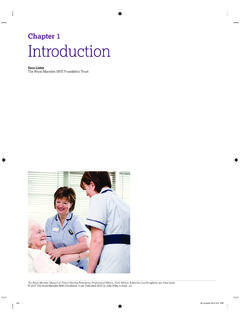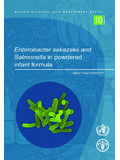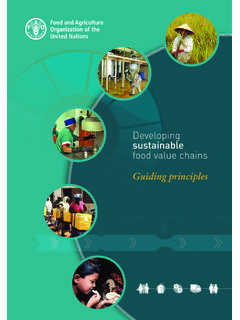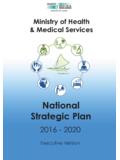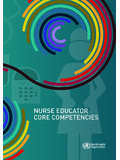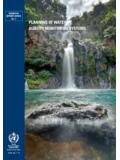Transcription of Detailed table of contents - The Royal Marsden …
1 Ftoc vii 23 December 2014 3:35 PMDetailed table of contentsBrief table of contents vForeword to the ninth edition xiiiAcknowledgements xivList of contributors xvList of abbreviations xixQuick reference to the procedure guidelines xxiiiHow to use your manual xxvii1 Introduction 1 Overview 2 Evidence-based practice 2 What is evidence-based practice? 2 Grading evidence in The Royal Marsden Manual of Clinical Nursing Procedures3 Structure of the Manual 4 Structure of chapters 4 Conclusion 4 References 4 Part OneManaging the patient journey 72 Assessment and discharge 9 Overview 10 Inpatient assessment and the process of care 10 Observation 19 Physical assessment/examination 19 Respiratory examination 21 Cardiovascular examination 26 Abdominal examination 30 Communication and discharge planning 34 References 45 Procedure guidelines for Chapter Respiratory examination Cardiovascular examination Abdominal examination 323 Infection prevention and control 49 Overview 50 Infection prevention and control 50 Aseptic technique 78 Source isolation 80 Protective isolation 86 Prevention and management of inoculation injury 88 Management of waste in the healthcare environment 89 Management of
2 Soiled linen in the healthcare environment 91 References 92 Procedure guidelines for Chapter Hand washing Hand decontamination using alcohol handrub Putting on and removing non-sterile gloves Putting on and removing a disposable apron Putting on and removing a disposable mask or respirator Putting on or removing goggles or a face shield Surgical scrub technique Donning sterile gloves: open technique Donning a sterile gown and gloves: closed technique Aseptic technique example: changing a wound dressing Source isolation: preparing an isolation room Source isolation: entering the isolation room Source isolation: leaving the isolation room Source isolation: transporting infected patients outside the source isolation area Protective isolation: preparing the room Protective isolation: entering the isolation room Safe disposal of foul, infected or infested linen 92 Part TwoSupporting the patient with human functioning 954 Communication 97 Overview 98 Communication 98 Communicating with those who are worried or distressed 108 Informing patients110 Communicating with those with specifi c psychological needs 113 Denial and collusion 113 Anxiety114 Panic attacks (acute anxiety) 115 Depression116 Anger, aggression and violence management 118 Delirium121 Dementia123 Acquired communication disorders 124 Websites and useful addresses 128 References 128 The Royal Marsden Manual of Clinical Nursing Proceduresftoc viii 23 December 2014 3.
3 35 PM5 Elimination 133 Overview 134 Normal elimination 134 Vomiting 134 Insertion of a nasogastric drainage tube 135 Removal of a nasogastric drainage tube 138 Urinary elimination 138 Faecal elimination 139 Assisting the patient with elimination 141 Altered urinary elimination 144 Urinary incontinence 144 Urinary catheterization 147 Suprapubic catheterization 155 Intermittent catheterization 155 Bladder irrigation 160 Nephrostomy tubes 166 Surgical urinary diversions 170 Altered faecal elimination 173 Diarrhoea 173 Constipation 175 Enemas 179 Suppositories 183 Digital rectal examination 185 Digital removal of faeces 187 Stoma care 189 Complications 199 Websites 199 References 202 Procedure guidelines for Chapter Care of a patient who is vomiting Insertion of a nasogastric (NG) drainage tube Removal of a nasogastric tube Slipper bedpan use: assisting a patient Commode use: assisting a patient Penile sheath application Urinary catheterization: male Urinary catheterization: female Urinary catheterization: intermittent self-catheterization patient guidance: male Urinary catheterization: intermittent self-catheterization patient guidance: female Urinary catheter bag.
4 Emptying Urinary catheter removal Commencing bladder irrigation Care of the patient during bladder irrigation Nephrostomy tube: weekly dressing and bag change Nephrostomy tube: removal of locking pigtail drainage system Continent urinary diversion stoma: self-catheterization Enema administration Suppository administration Digital rectal examination Digital removal of faeces Stoma siting Stoma bag change Stoma bridge or rod removal 1966 Moving and positioning 207 Overview 208 Moving and positioning: general principles 208 Risk assessment: prevention of falls 212 Positioning the patient: in bed 213 Positioning the patient: sitting in bed 214 Positioning the patient: side-lying 215 Positioning the patient: in a chair/wheelchair 217 Moving the patient from sitting to standing 218 Walking 219 Moving and positioning the unconscious patient 221 Moving and positioning the patient with an artifi cial airway 222 Moving and positioning the patient with respiratory compromise 225 Positioning to maximize ventilation/perfusion matching 225 Positioning to minimize the work of breathing 227 Positioning to maximize the drainage of secretions 228 Moving and positioning the patient with neurological impairment 230 Moving and positioning of the patient with actual or suspected spinal cord compression or spinal cord injury 235 Moving and positioning the patient with an amputation 246 Websites 249 References 249 Procedure guidelines for Chapter Positioning the patient: supine Positioning the patient.
5 Sitting in bed Positioning the patient: side-lying Positioning the patient: lying down to sitting up Positioning the patient: in a chair/wheelchair Moving from sitting to standing: assisting the patient Assisting the patient to walk Positioning the unconscious patient or patient with an airway in supine Positioning the unconscious patient or patient with an airway in side-lying Positioning the patient to maximize V/Q matching with unilateral lung disease in a self-ventilating patient Positioning the patient to maximize V/Q matching for widespread pathology in a self-ventilating patient Positioning to maximize the drainage of secretions Positioning the neurological patient with tonal problems Log rolling for suspected/confi rmed cervical spinal instability Positioning for suspected/confi rmed cervical spinal instability: pelvic twist to right Log rolling for suspected/confi rmed thoracolumbar spinal instability Early mobilization of the patient in bed Positioning the pre-operative and post-operative amputation patient 2477 Nutrition, fl uid balance and blood transfusion 253 Overview 254 Fluid balance 254 Nutritional status 266 Provision of nutritional support: oral 272 Nutritional management of patients with dysphagia 277 Detailed table of contentsftoc ix 23 December 2014 3:35 PMEnteral tube feeding 279 Enteral tube insertion 280 Enteral tube removal 287 Enteral tube care 288 Administration of enteral tube feed 294 Enteral feeding tubes: administration of medication 296 Enteral feeding tubes: unblocking 298 Parenteral nutrition 299 Transfusion of blood and blood components 302 Websites and useful addresses 323 References 324 Procedure guidelines for Chapter Fluid input.
6 Measurement Fluid output: monitoring/measuring output if the patient is catheterized Fluid output: monitoring/measuring output if the patient is not catheterized Fluid output: measuring output from drains Fluid output: monitoring output from gastric outlets, nasogastric tubes, gastrostomy Fluid output: monitoring output from bowels Fluid output: monitoring output from stoma sites Measuring the weight and height of the patient Feeding an adult patient Nasogastric intubation with tubes using an internal guidewire or stylet Removal of a nasogastric tube Percutaneous endoscopically placed gastrostomy (PEG) tube care Radiologically inserted gastrostomy (RIG) tube care Removal of T-fasteners Checking the balloon volume on a balloon gastrostomy Jejunostomy feeding tube care Enteral feeding tubes: administration of feed Enteral feeding tubes: administration of medication Enteral feeding tubes: unblocking Blood product request Blood sampling: pre-transfusion Blood components: collection and delivery to the clinical area Blood component administration 3168 Patient comfort and end-of-life care 331 Overview 332 Personal hygiene 332 Eye care 340 Ear care 350 Mouth care 352 Pain 360 Pain management 366 Acupuncture 373 Epidural and intrathecal analgesia 376 Regional analgesia.
7 Local anaesthetic nerve blocks and infusions 388 Entonox administration 391 Management of ascites 396 End-of-life care 402 Care before death 403 Care after death (last offi ces) 413 Websites 421 References 421 Procedure guidelines for Chapter Bedbathing a patient Washing a patient s hair in bed Eye swabbing Eye irrigation Artifi cial eye care: insertion Artifi cial eye care: removal Contact lens removal: hard lenses Contact lens removal: soft lenses Mouth care Mouth care for the patient with dentures Pain assessment Acupuncture: preparation and administration Epidural/intrathecal sensory blockade: assessment Epidural/intrathecal exit site dressing change Epidural/intrathecal catheter removal Entonox administration Abdominal paracentesis Personal care after death 4169 Respiratory care 431 Overview 432 Respiratory therapy 432 Oxygen therapy 434 Humidifi cation 441 High-fl ow oxygen therapy 444 Continuous positive airway pressure 446 Chest drains 452 Tracheostomy and laryngectomy care 467 Tracheostomy: dressing change 475 Tracheostomy: suctioning 476 Tracheostomy: changing the inner cannula 479 Tracheostomy: tube change 481 Cardiopulmonary resuscitation 484 References 502 Procedure guidelines for Chapter Oxygen therapy Humidifi cation for respiratory High-fl ow oxygen Continuous positive airway pressure Chest drain: insertion Chest drainage: suction Chest drain.
8 Priming ambulatory chest drain bag Chest drain: changing the bottle Chest drain: removal Tracheostomy: dressing change Tracheostomy: suctioning a patient Tracheostomy: inner cannula change Tracheostomy: tube change Cardiopulmonary resuscitation 498 Part ThreeSupporting the patient through the diagnostic process 50710 Interpreting diagnostic tests 509 Overview 510 Diagnostic tests 510 The Royal Marsden Manual of Clinical Nursing Proceduresftoc x 23 December 2014 3:35 PMBlood: obtaining samples from a peripheral vein (venepuncture) 514 Blood sampling from a central venous catheter 524 Arterial sampling 527 Blood tests 534 Blood cultures 535 Post-procedural considerations 539 Antimicrobial drug assay 540 Cerebrospinal fl uid obtained by lumbar puncture 541 Semen collection 547 Cervical uterine smear (pap smear) 550 Specimen collection: swab sampling 557 Specimen collection: urine sampling 565 Specimen collection: faecal sampling 571 Specimen collection: respiratory tract secretion sampling 573 Specimen collection: pleural fl uid 578 Endoscopic investigations 579 Gastroscopy 579 Colonoscopy 581 Cystoscopy 582 Liver biopsy 583 Radiological investigations: X-ray 585 Magnetic resonance imaging 586 Computed tomography 587 Websites 587 References 588 Procedure guidelines for Chapter Venepuncture Central venous access devices: taking a blood sample for vacuum sampling Central venous access devices: taking a blood sample for syringe sampling Arterial puncture.
9 Radial artery Arterial blood gas sampling: arterial cannula Blood cultures: peripheral (winged device collection method) Blood cultures: central venous access device Blood sampling: antimicrobial drug assay Lumbar puncture Semen collection Cervical uterine smear using a wooden spatula Cervical uterine smear using liquid-based cytology Cervical uterine smear using an endocervical brush Swab sampling: ear Swab sampling: eye Swab sampling: nose Swab sampling: penis Swab sampling: rectum Swab sampling: skin Swab sampling: throat Swab sampling: vagina Swab sampling: wound Urine sampling: midstream specimen of urine: male Urine sampling: midstream specimen of urine: female Urine sampling: catheter specimen of urine (CSU) Urine sampling: sampling from an ileal conduit Urine sampling: 24-h


